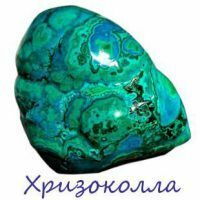
The chrysocolla stone is one of the most mysterious minerals, whose properties, origin, chemical composition and species identity are not fully understood.
- Stone history
- Description of the mineral
- Chrysocolla species
- Chemical composition and physical properties of the stone
- Deposits of the chrysocolla
- The healing properties of the mineral
- The magical properties of the chrysocolla
- Chrysocolla and the zodiac signs
- Application of the gem
- Interesting facts about the stone
- How to distinguish the natural chrysocoll from a fake
- Stone Care
- Photos of the chrysocolla and its products
History of the stone
Chrysocolla is one of the most ancient gemss. Scientists find numerous evidence of its use by ancient peoples.
- The inhabitants of Ancient Egypt made from a mixture of chrysocolla and malachite a special paint of blue and green color - frit. With the help of this paint, wall murals were created, which adorned the pyramids and ancient temples, made paintings on dishes, drawings on jewelry. And Egyptian women used frit for cosmetic purposes - as beautiful blue, green and blue eye shadow. The chrysocolla was used by the Egyptians and for the production of a unique mosaic tile. The richness of its color opened up great opportunities for the realization of creative design.
- The peoples of the Andes, who inhabited this area before the Incas, used chrysocolla as a jewelery and ornamental stone. These traditions have survived to this day. And today, jewelers and artisans of the countries of South America make from this stone figurines, beads, cabochons for rings and earrings.
- Inhabitants of Peru encrusted gold jewelry with chrysolite. Such jewelry was found in the numerous burials found among the ruins of the ancient city of Kantur-Wassi, the period of prosperity which occurred in the I millennium BC.
- But the main area of application of the chrysocolla in antiquity was the soldering of gold items. This fragile and light rock was used as a solder of gold or "golden glue".Hence the name of the stone - the chrysocolla, consisting of two words: "chrysos"( "χρυσός") and "kolla"( "κόλλα"), which are translated from Greek as "gold" and "glue".This name was given to the mineral by Theophrastus( the famous ancient Greek scholar) in 4 tbsp. BC.e.
Description of the mineral
Externally, the chrysocolla is very similar to turquoise, malachite and azurite, it's no wonder that it is often confused with these minerals, especially since the chrysocolla literally "fuses" with them. However, despite the external similarity - this is an absolutely different stone, with different properties and chemical composition.
This is a light opaque mineral with a wax or glass shine of a blue-green color scheme. Most often there are samples of chrysocolla of a pleasant sky-blue, blue or greenish-blue color, but sometimes specimens of a brownish hue come across.
Different peoples called this unusual stone and its varieties in different ways: greenery of mountain, demidovite, greens of copper, golden weed, copper malachite.
But, perhaps, the most unusual and beautiful name of the chrysocolla is the Elat or Eilat stone, which it received under the name of the Israeli city of Eilat, located at the Eilat Gulf of the same name, where it was mined in antiquity.
to contents ^Varieties of chrysocolla
The following basic chrysocolla species are distinguished:
- Asperolite is a bluish-green chrysocolla formed as fragile kidney-like masses. This is a kind of chrysocolla with a high water content.
- Bisbiit is a blue chrysocolla. This is a kind of chrysocolla with a low water content.
- Demidovit is a dense chrysocolla of sky-blue, blue or greenish color, formed in the form of thin integuments - crusts of mineral on malachite. This is one of the most expensive varieties of chrysocolla, a good jewelry and ornamental stone, often used to imitate turquoise.
There are varieties of chrysocolla and for deposits:
- the Mexican chrysocolla;
- the Chrysocolla is Arizona;
- Peruvian chrysocolla.
Chemical composition and physical properties of the stone
The chemical composition of the chrysocolla is a complex water silicate of copper and aluminum. Its chemical formula:( Cu, Al) 2H2Si2O5( OH) 4nH2O.However, the content of the main components in the mineral composition is not constant and can fluctuate greatly.
So, for example:
- The content of copper( Cu) can vary from 16 to 75%;
- The content of silicic acid( H2Si2O5) can vary from 10 to 67%;
- The water content( H2O) can vary from 7 to 31%.
In addition, the chrysocolla can contain impurities that change both its density, and color, and the very structure of the gem.
The high content of copper gives the chrysocolla a beautiful turquoise color, and the combination of copper, aluminum and iron gives the mineral a green tint. Due to the impurities of kaolinite, a chrysocolla of heavenly color is formed, and the presence of manganese gives a brownish shade to the mineral.
Depending on its structure, the chrysocolla can be very fragile and soft, and can be more dense and harder. In denser and harder specimens, one can see a glass wax luster, which in less dense varieties is absent.
In nature, the chrysocolla is found in the form of kidney-shaped or grooved translucent or translucent aggregates, crusts, dense enamel-like or earthy masses.
The hardness of the chrysocolla is only 2.0-4.0 units on the Mohs scale, and the density varies from 2 to 2.4 g / cm3.
Chrysocolla readily dissolves in acids, releasing silicic acid in the form of a powder.
to contents ^Deposits of chrysocolla
The main deposits of chrysocolla are found in Russia( in the Turin mines), in Kazakhstan, the USA, Chile, Peru and Zaire.
to contents ^The healing properties of the mineral
Therapeutic properties of chrysocolla, in the opinion of lithotherapists, are most effective for the treatment of female diseases. It is used for:
- acute menstrual pain;
- menstrual irregularities;
- ovarian dysfunction;
- inflammation of the female genital organs.
Traditional healers attribute this mineral the ability to help with such diseases as:
- bronchitis;
- cold;
- throat diseases;
- chronic cough;
- thyroid dysfunction.
It is useful to consider the impact of a chrysocolla on a person's psychoemotional state.
In particular, it is recommended to wear when:
- nervous exhaustion;
- insomnia;
- apathy;
- oppression;
- of depression.
Magic properties of chrysocolla
Chrysocolla is considered to be a female stone, so its magical influence on women is especially great.
This amazing mineral, thanks to its magical properties, can help a woman to reveal her inner world and better understand the surrounding reality.
Chrysocolla makes its owner subtle, gentle and feminine, develops in her maternal feelings and spiritual kindness. No wonder the ancient magicians advised their husbands to present as gifts to their wives jewelry from the chrysocolla, in order to develop in them a feminine and the best spiritual qualities.
In addition, very powerful amulets and amulets were made from chrysocolla to protect against temptations and fears, dark forces and evil spirits.
to contents ^Chrysocolla and zodiac signs
According to astrologers, the chrysocolla and its products are most suitable for Taurus and Sagittarius. Thanks to this stone, people born under the signs of Sagittarius and Taurus can acquire wisdom and develop their intuition.
Favorably affects the wearing of amulets and ornaments with chrysocolla and on people born under the signs:
- Libra;
- of the Lion;
- Aquarius;
- Cancer.
Application of the gem
Chrysocolla is of particular interest to collectors, and is also used to make:
- jewelry;
- decor elements;
- of souvenirs.
Interesting facts about the stone
The name of such a famous biblical hero as King Solomon is associated with the chrysalis. There is an opinion that it was thanks to this amazing stone that Solomon got all his wealth. The Elat stone, as the chrysocolla was then called, was highly valued during the reign of the biblical king and helped him to turn his country into a powerful state.
to contents ^How to distinguish natural chrysocolla from forgery
There is a fairly simple and reliable way to determine the naturalness of a chrysocolla. It is not necessary to conduct special analyzes and experiments, it is enough just to touch the stone with the tip of the tongue. The natural chrysocolla, being a water silicate of aluminum and copper, literally clings to the tongue. Moreover, the degree of its "adherence" depends on the saturation of water: the less the water content in the stone - the more it clings to the tongue.
to the table of contents ^Care for the stone
Chrysocolla is a very fragile stone and requires special attention and care. This stone should be protected from:
- sharp temperature changes;
- heating;
- exposure to acids;
- strokes;
- impact of abrasives and vapors;
- contact with other stones;
- long-term exposure to water.
You can not clean the chrysocolla by ultrasound, steam, or even a soapy solution. Do not wash the chrysocolla in water.water can affect its color and structure.
It is sometimes enough to wipe a stone with a soft flannel, suede or woolen cloth.
to the table of contents ^Photos of the chrysocolla and its products
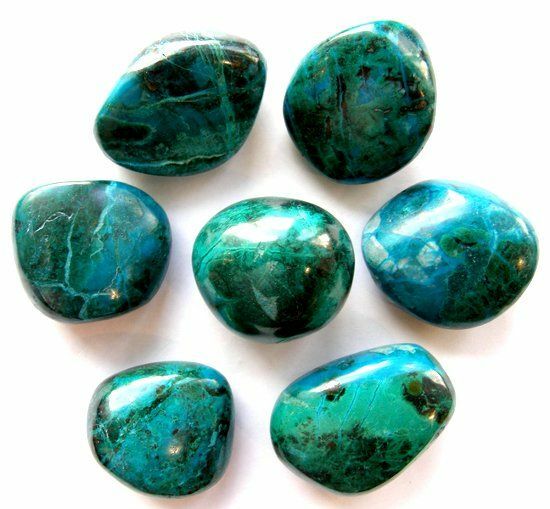
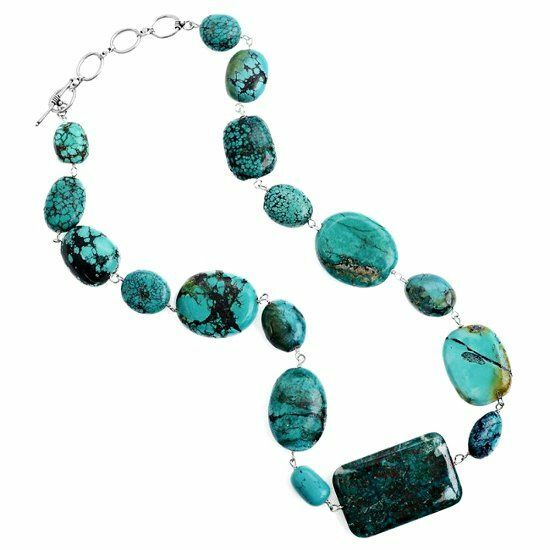
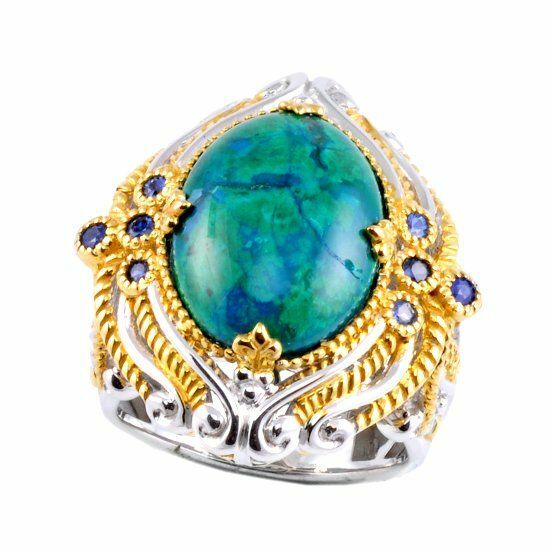
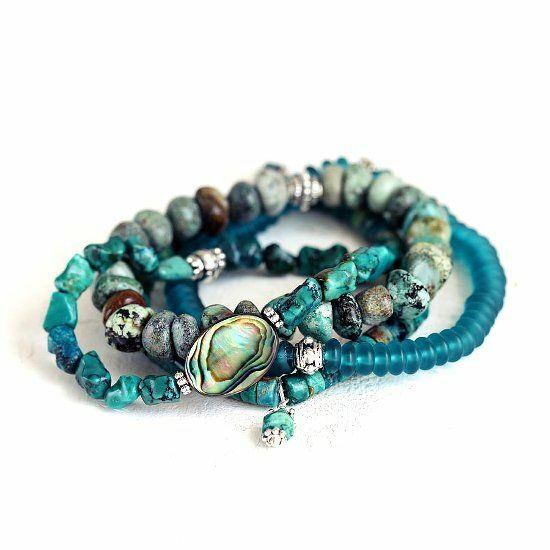
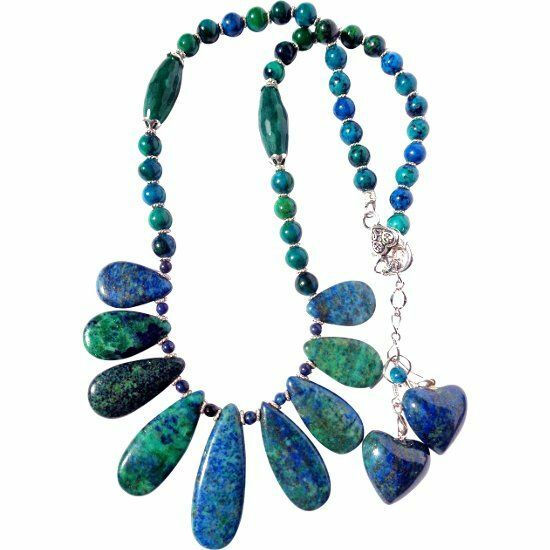
Yes, that's right. His influence on the function of thinking to take alcohol, restraining from drinking.
Yes, and if you attach a cobble to the neck with a kilo under 70, then you'll quit drinking altogether.on the booze does not reach, and the head with such weight does not raise, that would knock the glass: -))))))))))
I also heard)) In the new season number 16 Battle of the extras MarilynKerr had advised wearing a chrysocolla around her neck or on her arm like a bracelet. To get rid of thoughts about alcohol.
I just watched the broadcast from the channel TNT TV "Battle of psychics".One of the strongest psychics, Marilyn Kiro, advised a girl with alcoholism to wear this stone around her neck, or as a bracelet. As a ring, this stone has no effect.
Read here that the stone is female, but can his man be worn with alcoholism? Or is another stone used for men?
All descriptions of the stone correspond to reality, it even clings to the hand and fingers. I prefer natural without cutting. With regard to the difference in the effect on the floor, people have not heard, but on the other hand, the excess will not grow, but thoughts need to be cleaned with good intentions.
Interestingly, does the chrysocolla from the press also stick to the language? Such a stone( pressed) no longer carries in itself anything magical.
And what is the approximate price of this stone?

I heard that this stone protects against alcohol if it is worn around the neck?